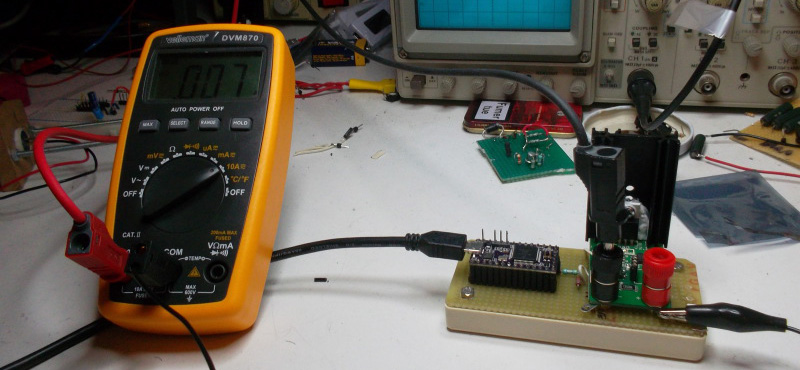[Texane]’s job requires testing a few boards under a set of loads, and although the lab at work has some professional tools for this it seemed like a great opportunity to try out the Re:load 2. It’s a nifty little active load that’s available can of course be improved with an injection of solder and silicon.
While the Re:load 2 is a nice, simple device that can turn up to 12 Watts directly into heat, it’s not programmable. The ability to create and save load profiles would be a handy feature to have, so [Texane] took a Teensy 3.1 microcontroller and installed a resistor divider in front of the Re:load’s amplifier. A simple script running on a computer allows [Texane] to set the amount of current dumped and automate ramps and timers.
There is a more fundamental problem with the Re:load; the lowest possible current that can be dumped into a heat sink is 90mA. [Texane] replace the amplifier with a zero-drift amp that brought that 90mA figure down to 7mA.
Of course the Re:load and Teensy 3.1 are sold in the Hackaday store, but if you’re looking for a ready-built solution for a computer-controlled active load you can always check out the Re:load Pro, a fancy-smanchy model that has an LCD. The Pro costs more, and [Texane] just told you how to get the same features with the less expensive model we’re selling, though…

















s/fancy-smanchy/fancy-schmancy/ (it has to rhyme)
Also, you seem to have left out a good chunk of text in the first paragraph. I can’t figure out what that to fill in for that final ellipsis. Maybe the “and” should be a “but”, and the “though…” should be “so…”.
You should just make blog posts like little wiki articles, so we can fix stuff like this for you :P
I just wanted to say “Bravo!” for posting how those with the appropriate skill set can save some money by buying the *cheaper* option from your store. A lot of sites wouldn’t even allow such a post.
you heard it once, you’ll hear it again: Hackaday is not most sites
Mutter mutter grumble.
(I kid. Good post!)
Brian: You need to do some proof-reading! “It’s a nifty little active load that’s available can of course be improved with an injection of solder and silicon” … Eh, something is missing.
My own personal Re:load hack was to make my own little voltmeter for it to act as the display for what the current setting is. I took an ATTIny84, a BCD-to-7-segment converter and 4 7 segment LED displays. I also have a 1.8 volt regulator to supply AREF. The output voltage is 0.1V = 1A, and I have it set up with a fixed x.xxx format so it will directly display 0-9 A. Wired up this way, as well, I can have the Re:load and my display box externally powered so I can dial the load where I want it before turning on the power supply I am trying to test.